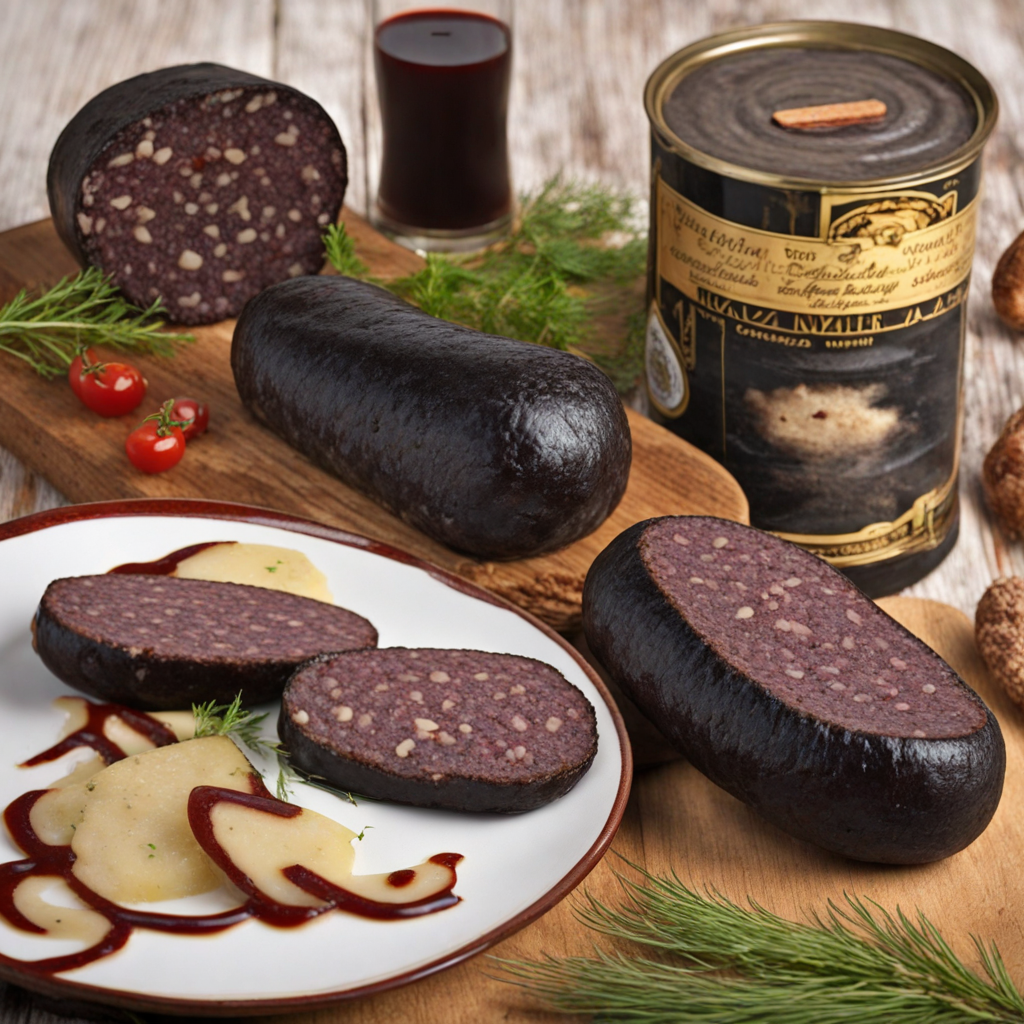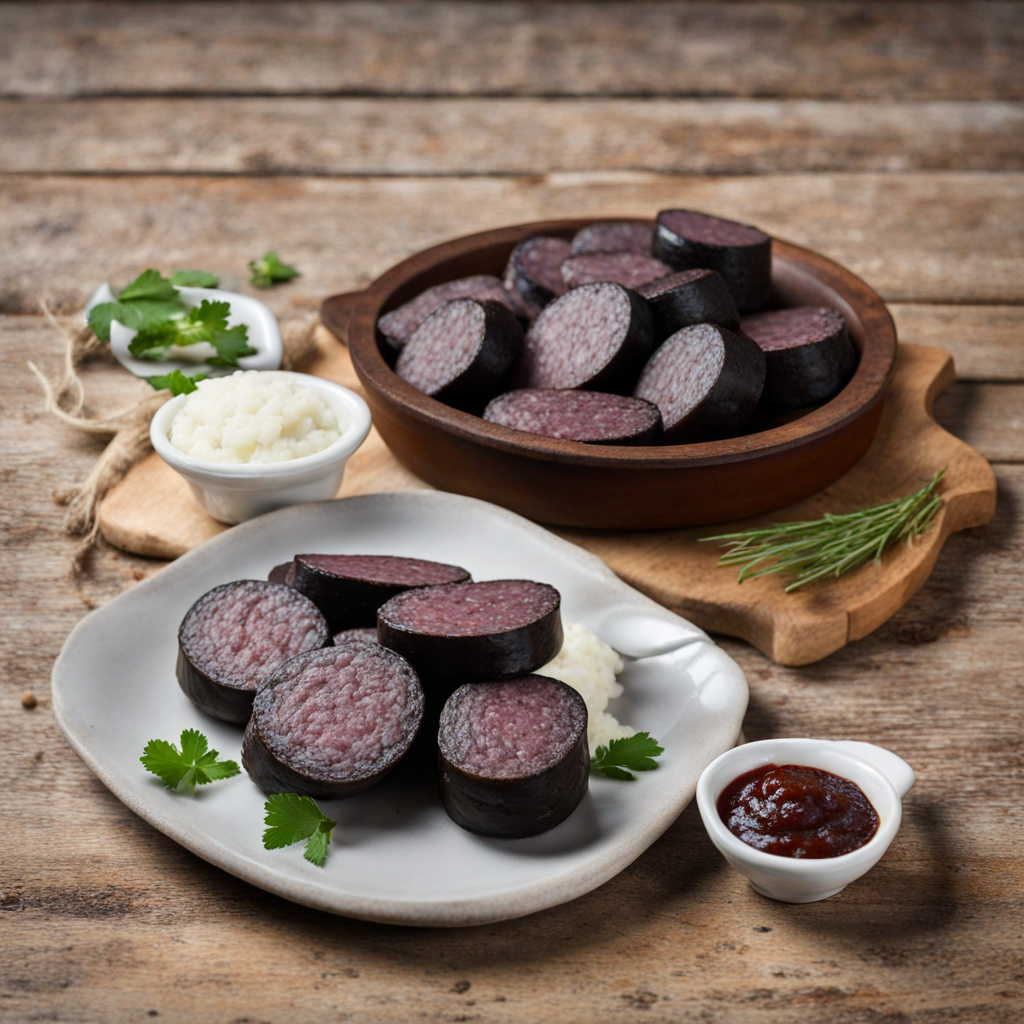Black Pudding
Black pudding, a traditional Slovenian delicacy, is a type of blood sausage that embodies the rich flavors and culinary history of the region. Made primarily from pig's blood, fat, and a blend of spices, this dish showcases a deep, dark hue and a distinct earthy aroma. The use of ingredients such as barley or rice contributes to its hearty texture, while the seasoning often includes salt, pepper, and various herbs, giving it a unique and robust flavor profile that can vary by locality and family recipe. This sausage is typically encased in natural hog casings, resulting in a satisfyingly firm bite that complements its savory filling. In Slovenia, black pudding is often enjoyed as part of a traditional breakfast or served with a selection of side dishes. It is frequently paired with sauerkraut or potatoes, which enhance its flavor and provide a delightful contrast in texture. When cooked, black pudding develops a crispy exterior while maintaining its rich, moist interior. The dish can be grilled, fried, or even baked, making it versatile for various meal preparations. Its bold taste is not only satisfying but also evokes a sense of comfort and nostalgia, connecting diners to the heritage of Slovenian cuisine. Exploring black pudding opens up a world of culinary experiences, as it is a dish that encourages sharing and socializing. Often served at festive gatherings or family meals, this sausage brings people together over its hearty, filling nature. The unique combination of spices and ingredients not only tantalizes the palate but also sparks curiosity about the traditions and stories behind its preparation. For those looking to expand their culinary horizons, black pudding is a must-try, offering a taste of Slovenia's rich culture and gastronomic heritage.
How It Became This Dish
The Rich History of Črna Klobasa: Slovenia’s Black Sausage Slovenia, a country nestled in the heart of Europe, boasts a culinary heritage that reflects its diverse geography and rich cultural tapestry. Among its many traditional foods, one of the most distinctive is the Črna klobasa, or black sausage, a delicacy that has become a cherished symbol of Slovenian gastronomy. This savory sausage not only tantalizes the palate but also tells a story of the land, its people, and their traditions. #### Origins: The Birth of Črna Klobasa The origins of Črna klobasa can be traced back to the rural communities of Slovenia, particularly in the regions of Prekmurje and the Savinja Valley. Historically, the production of sausages was a way to preserve meat, especially during the winter months when fresh food was scarce. The cold climate necessitated clever methods of food preservation, and curing meat through smoking and seasoning became a vital part of Slovenian culinary practices. Črna klobasa is primarily made from pork, which was a staple in rural households. The use of blood as a key ingredient sets it apart from other sausages. The blood is mixed with a blend of spices, including salt, pepper, and garlic, and combined with rice or barley for texture. The mixture is then stuffed into natural casings and smoked, giving the sausage its signature dark color and rich flavor. The practice of using blood in sausages can be linked to ancient European culinary traditions, where blood was a valuable source of nourishment and flavor. #### Cultural Significance: A Sausage with Roots The making of Črna klobasa is more than just a culinary process; it is a cultural ritual. Traditionally, families would gather to make sausages during the winter months, turning the preparation into a communal event. This practice is often referred to as “kolin,” which is a term used for the slaughter of pigs in Slovenian culture. The kolin season, usually occurring in late autumn, marks a time of festivity and bonding among family and friends. In many Slovenian households, Črna klobasa is a staple during festive occasions, particularly during Christmas and Easter. It is often served with sour cabbage or polenta, creating a hearty meal that reflects the country's agricultural roots. Moreover, Črna klobasa is featured in various regional festivals, where it is celebrated alongside other traditional foods, showcasing Slovenia's rich culinary heritage to both locals and visitors. #### Development Over Time: From Tradition to Modernity As Slovenia transitioned from a predominantly agricultural society to a more urbanized one during the 20th century, the production of Črna klobasa evolved. While traditional methods of sausage-making are still cherished, modern techniques and innovations have emerged. Today, many artisanal producers and small-scale farms continue to uphold the time-honored practices, ensuring that the quality and authenticity of Črna klobasa remain intact. With the rise of the slow food movement and an increasing interest in local and sustainable foods, Črna klobasa has gained recognition beyond Slovenia’s borders. It has found its way into gourmet restaurants and international food festivals, where chefs experiment with the sausage, pairing it with various accompaniments and elevating it to new culinary heights. This newfound appreciation for Črna klobasa has not only contributed to its popularity but also sparked a resurgence in traditional sausage-making practices among younger generations. #### Regional Variations and Modern Twists While Črna klobasa is a beloved staple throughout Slovenia, there are regional variations that reflect local tastes and traditions. In Prekmurje, for example, the sausage may be made with a higher proportion of barley, while in other regions, it might incorporate different spices or additional ingredients, such as herbs. These variations showcase the adaptability of Črna klobasa and its ability to reflect the local landscape and culinary preferences. Contemporary chefs have also begun to experiment with Črna klobasa, pairing it with flavors and ingredients that were traditionally not associated with this sausage. Some have introduced it into modern dishes like gourmet pizzas, or used it as a filling for ravioli, showcasing its versatility and potential for reinvention. Despite these modern twists, the essence of Črna klobasa remains rooted in its traditional preparation and cultural significance. #### The Future of Črna Klobasa As Slovenia continues to embrace its culinary heritage, the future of Črna klobasa looks promising. With an increasing focus on local food systems and traditional methods, there is a growing appreciation for artisanal producers who prioritize quality and authenticity. Efforts to promote Slovenian cuisine on the global stage have also led to increased interest in Črna klobasa, with food enthusiasts eager to explore this unique delicacy. Moreover, initiatives aimed at preserving traditional food practices, such as workshops and cultural events, are helping to educate younger generations about the importance of their culinary heritage. Through these efforts, Črna klobasa is not just a food item; it is a living tradition that continues to evolve while maintaining its historical roots. #### Conclusion: A Delicacy That Unites Črna klobasa is more than just a black sausage; it is a testament to Slovenia's rich culinary heritage, representing the resilience and creativity of its people. With its deep historical roots, cultural significance, and evolving nature, Črna klobasa encapsulates the essence of Slovenian cuisine. As it continues to delight palates both locally and globally, it serves as a reminder of the importance of tradition, community, and the joys of sharing food. Whether enjoyed at a festive gathering or savored in a modern culinary creation, Črna klobasa remains a beloved symbol of Slovenia's gastronomic identity, bridging the past with the present and paving the way for future generations to appreciate its unique flavors.
You may like
Discover local flavors from Slovenia







